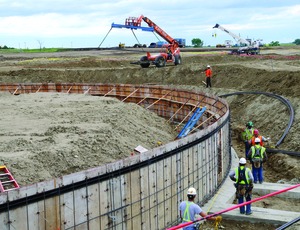
Some say it is the biggest construction project in the U.S.—a job requiring $8 billion in rail and fuel terminals, oil pipelines, natural-gas plants, oil wells, highway upgrades, water distribution systems and more.
To others, it is the Bakken shale formation, a 15,000-sq-mile oil field straddling North Dakota and Montana and producing 300,000 barrels per day of crude oil. Its output is expected to increase to 1.2 million barrels per day by 2015.
The number of construction projects, speed of growth and cold-climate challenges are mind-boggling. Ed Greenberg, a spokesman for the Canadian Pacific Railway, says, “I'd almost compare it to building the Alaska Pipeline.” CP is planning to spend up to $110 million to expand track and yard capacity in North Dakota by the end of 2012.
North Dakota's only refinery in operation, a Tesoro facility near Mandan, has plans to expand its capacity from 58,000 bbl per day to 68,000 bbl per day by the second quarter of 2012. There is little other refinery or oil pipeline capacity in the area, however, and companies would like to get product as far as the Gulf of Mexico. “We want to be shipping 80-car-unit trains to the Gulf on a weekly basis,” Greenberg says.
In the past, rail was not considered a cost-effective solution for crude transport, but lessons learned in the biofuels sector have made shipping crude by rail more feasible, says Chris Keene, CEO of Rangeland Energy, Sugarland, Texas. The company is building a $70-million crude oil terminal and rail loading facility in Williams County, N.D. It will be North Dakota's “first open-access crude oil marketing hub and is expected to be in service by January 2012,” Keene says.
In similar developments, Wilson Co., Houston, has helped oil exploration and production company EOG Resources, Houston, install a rail loading facility at Stanley, N.D., that went operational in December.
Pipeline plans are in development, too. Montana Gov. Brian Schweitzer (D) sent a July 4 letter to Secretary of State Hillary Clinton on behalf of TransCanada's Keystone Pipeline urging the U.S. State Dept. to complete its analysis and permitting activities. In addition to the Keystone project, portions of the Plains Bakken pipeline are under construction, says Justin Kringstad, a spokesman for the North Dakota Pipeline Authority. “All systems are go on the Plains project,” he says, noting that this project and other pipeline work under way add up to about $1 billion in new construction.

Post a comment to this article
Report Abusive Comment